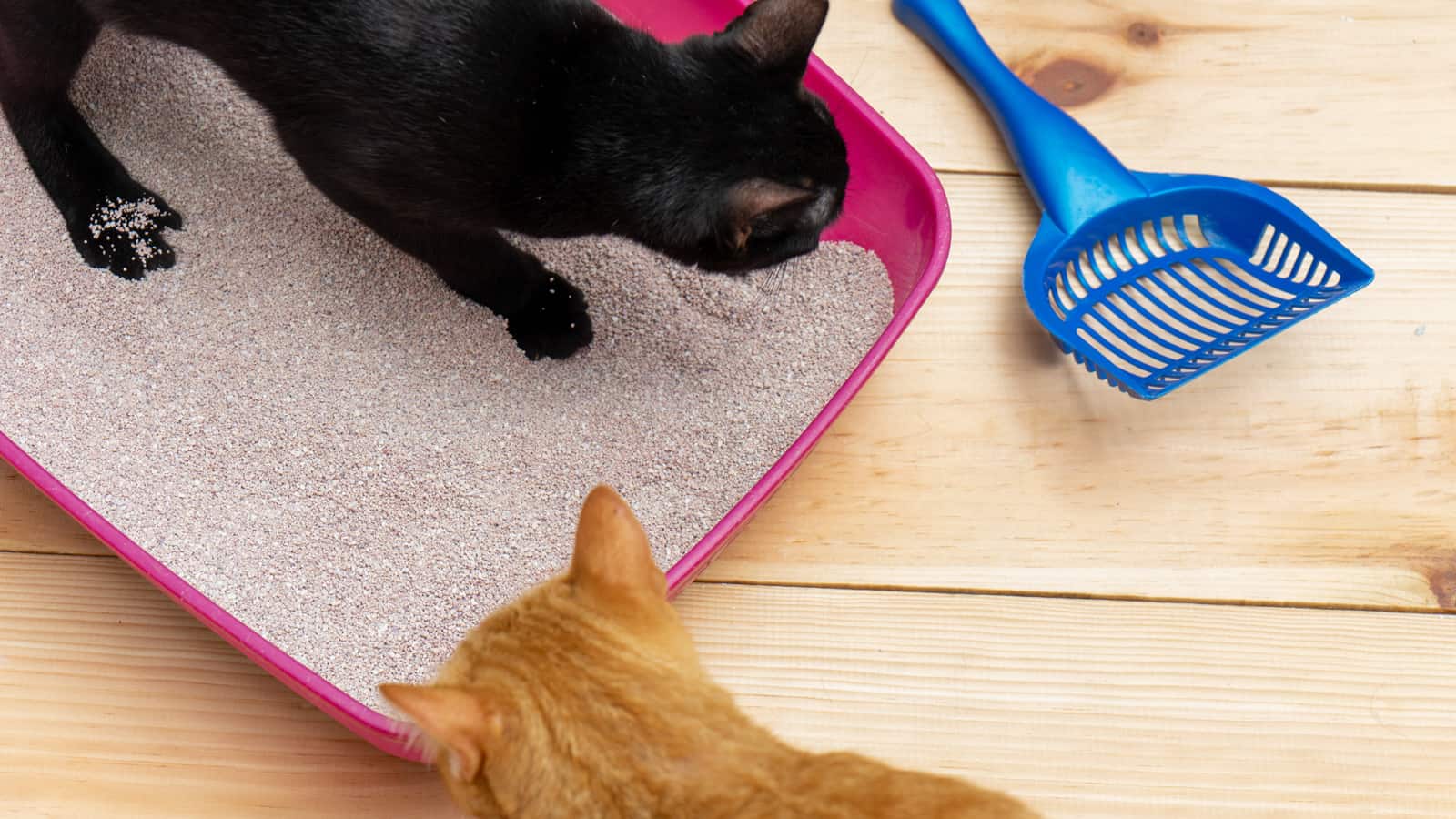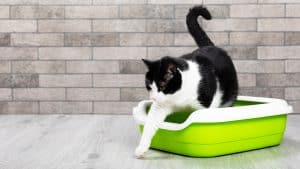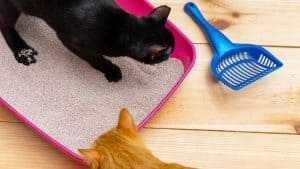Are you fed up with the unpleasant aroma from your cat's litter box in your cozy apartment?
Maintaining a clean litter box isn't just about combating odors; it's crucial for your health and your feline friend's well-being.
Navigating this challenge in a limited living space can seem daunting, but don't worry—there are straightforward and efficient solutions.
Whether it's daily scooping, using the right tools, or even implementing a self-cleaning litter box, we've got tips that will make cleaning less of a chore.
So if you're looking for practical ways to keep your litter box spick and span without turning your apartment upside down, you've come to the right place.

Why a Clean Litter Box Matters: Don't Ignore These Factors
Taking care of your cat's needs is your daily routine, and it goes beyond just feeding and playtime. One chore that you can't afford to neglect? Keeping that litter box spotless.
The Risk to Your Cat's Health: No Joke!
Why the fuss over a clean litter box? A dirty one is basically a playground for harmful bacteria and parasites.
These uninvited guests can quickly lead to nasty infections and illnesses in your cat. In some cases, the consequences could even be life-threatening diseases.
No one wants an emergency vet visit.
Your Home's Air Quality: It's Not Just About Smell
Forget air fresheners. If your litter box isn't clean, your entire home could stink. But it's not just about unpleasant odors.
A filthy litter box emits ammonia and other harmful substances that can degrade your indoor air quality. You're not just holding your nose; you're risking your well-being.
Your Cat's Bathroom Etiquette: Keep It Clean or Face the Consequences
Cats are clean animals; it's in their nature. Give them a dirty litter box, and they'll start turning up their noses.
Worse, they may boycott the litter box entirely. When that happens, don't be surprised to find a nasty "surprise" elsewhere in your home. Your furniture, carpet, or favorite plant could become the next go-to spot for your cat's bathroom breaks.
The Must-Have Toolkit for Litter Box Cleaning: What You Really Need
Cleaning your cat's litter box isn't just a chore; it's a necessity. And, like any task, having the right tools can make all the difference.
We're diving into the essentials that should be in your litter box cleaning toolkit. Make sure you're equipped to do the job right.
Gloves: Your First Line of Defense Against Germs
Handling waste is messy and risky—no two ways about it. Slip on a pair of gloves before you start. They shield your hands from direct contact with bacteria and other nasties.
Disposable gloves are convenient, but if you're eco-conscious, opt for reusable ones. Just wash them thoroughly with disinfectant after each use.
The Mighty Litter Scoop: Don't Skimp on This One
You're not just shoveling; you're maintaining a healthy environment. A quality litter scoop makes the task faster and more efficient.
Choose from plastic or metal scoops; each has its pros and cons. Make sure it fits well in your hand and can easily navigate the box's corners.
Trash Bags or Containers: The Final Resting Place for Waste
Once you've scooped, you need somewhere to put the waste. Use a designated trash bag or container. Not just any bag will do.
Go for biodegradable or eco-friendly options. They hold waste securely and lessen your carbon footprint.
Disinfectant Wipes: The Quick and Safe Cleanup Solution
After scooping, wipe down the litter box with disinfectant wipes. These wipes are designed to kill germs instantly.
Make sure to use pet-safe wipes that won't harm your cat if they decide to investigate their freshly cleaned box.
Check out these litter-box wipes on Amazon.
The Essential Garbage Bag: Your Waste Solution
Let's not forget about the final step: eliminating the waste. A heavy-duty garbage bag is your best friend here.
Choose a biodegradable one if possible. It's not just about convenience; it's about responsibility to your cat and the planet.
In a nutshell, the right tools make all the difference when it comes to cleaning your cat's litter box.
Stock up on these essentials, and you'll be well-equipped to keep that box—and your home—clean and odor-free.
Your Step-by-Step Guide to a Perfectly Clean Litter Box
Getting down and dirty with your cat's litter box might not be fun, but it's essential. The cleanliness of the litter box directly impacts your cat's health and your living space's air quality.
Below is a straightforward guide to make this task as painless as possible.
Follow these steps for a cleaner litter box and a happier home.
Phase 1: The Preparation Stage - Items You'll Need
First things first, gather your cleaning artillery. You will need:
- Litter scooper
- Trash bags
- Warm water
- Wet soapy sponge or scrub brush
- Mild non-scented detergent
- Towel
- Cat-safe disinfectant or pet-specific wipes
- Fresh litter
Phase 2: The Removal - Extract Waste and Clumps
Armed with your litter scooper, dive in. Target all solid waste and urine-soaked clumps. Scoop these out and make sure you get the corners.
Phase 3: Secure the Waste - Keep it Bagged
Seal the scooped waste in a trash bag. Tie it up tight to contain odors and bacteria. This isn't the stuff you want lingering around your home.
Phase 4: Initial Rinse - Wash Away Residue
Hold your nose and rinse the box. Use warm water to flush out any lingering waste or litter. This primes the box for a thorough scrubbing.
Phase 5: Scrub-a-Dub-Dub - Intense Cleaning
Grab that wet soapy sponge or scrub brush. Douse it in mild, non-scented detergent. Now scrub every nook and cranny of that box.
The goal is to get it as clean as new—or as close as possible.
Phase 6: Dry Off - Remove All Moisture
No one likes a soggy litter box, not even your cat. Use a towel to dry the box thoroughly. Make sure there's not a single wet spot left.
Phase 7: The Final Disinfecting Act - Safety First
Spritz a cat-safe disinfectant all over the litter box. This kills any lingering germs and provides an extra layer of protection for both your cat and you.
Phase 8: Fresh Start - Lay the Foundation
Now for the fun part: adding fresh litter. Make sure you pour enough to achieve a 2-3 inch depth. Your cat will appreciate the soft, clean landing.
The Ongoing Commitment: Regular Upkeep is Key
Let's face it: a one-time deep cleaning won't solve all your problems. Make this a regular affair. Consistent cleaning keeps the air fresh and your cat content.
Proper Waste Management: Don't Let Odors Escape
Managing waste is half the battle while cleaning your cat's litter box. Let's look at how to do this right.
Feces and Urine: Know the Difference
First off, distinguish between feces and urine clumps. Your strategy for each will differ. Feces require daily removal, while urine clumps can wait a few days.
Soiled Litter: Regular Replacement is a Must
Your litter won't last forever. Replace soiled litter with a fresh batch at least once a week. This halts odor buildup and keeps your living space smelling clean.
Solid Waste: Secure and Contain
Dispose of solid waste in a tightly sealed trash bin. This keeps nasty odors at bay and maintains a fresher atmosphere in your apartment.
By following these guidelines, you're making your living space more pleasant and creating a healthier environment for your cat.
Get into the routine, and it'll become second nature. Happy cleaning!
Cleaning Frequency and Schedule
Knowing when and how often to clean your cat's litter box can be a balancing act. Let's break it down. The number of cats you own directly impacts your cleaning schedule.
More cats equals more mess, meaning you should clean the litter box more frequently. The type of litter you use also matters.
Clumping litter, for instance, simplifies the scooping process, extending the time between full litter box cleanings. The size of the litter box plays a role, too; larger ones can handle more waste and thus require less frequent cleaning.
However, as a general rule of thumb, aim to clean the litter box at least once daily. You might want to double that frequency if your household has more than one cat.
Consider a deeper weekly clean for those seeking to go beyond the bare minimum. This isn't just a quick scoop and dash; it involves emptying the litter box entirely and giving it a proper wash with warm water and a cleaner.
If that sounds like a chore, technology has a solution. Self-cleaning litter boxes take over the grunt work of daily cleaning, giving you some much-needed respite.
Also read: How Often Should You Clean A Litter Box? [Answered]
Apartment Living: Keeping the Litter Box Smell in Check
When you share an enclosed space with a cat, odor control is another pressing issue—the good news, though: is that you can fight back.
Baking soda, your pantry's unsung hero, can be your first line of defense. Just sprinkle a layer at the bottom of the litter box before adding litter.
It's a natural deodorizer that neutralizes those stinky odors. Air purifiers can also make a world of difference.
These handy devices pull double duty by capturing airborne particles, including the unpleasant scents that sometimes waft from the litter box.
But remember, the most effective way to control odor is regular cleaning. Daily scooping and weekly deep cleans, aided by cat-safe disinfectants, keep those pungent smells at bay.
Also read: 12 Top Self-Cleaning Litter Boxes
Safety First: What to Avoid While Cleaning the Litter Box
Litter box cleaning may not be glamorous, but it’s essential for your living space and your cat's well-being. And like any task, it comes with its set of dos and don’ts.
Steer clear of harsh cleaning chemicals. They might promise a sparkling clean litter box, but at the cost of irritating your cat's eyes, skin, and respiratory system.
Instead, consider safer alternatives like pet-friendly disinfectants or a natural combo of baking soda and vinegar.
Also read: Should You Add Baking Soda to Cat Litter? – The Inside Scoop
And let’s not forget about urinary tract infections (UTIs), which are all too common in cats. Regular, thorough cleaning can be a preventive measure against these infections.
If your cat is already dealing with a UTI, it’s even more crucial to ramp up your cleaning efforts to stop the spread of bacteria.
Cleaning your cat's litter box may seem like a chore, but it's crucial for your pet's health and the overall freshness of your home.
Following these guidelines will make this task more manageable and create a better environment for everyone involved.
Also read: How To Get Rid Of Litter Box Smell
The Importance of Hand Hygiene Post-Cleanup
Cleaning your cat's litter box is a dirty job, but someone's got to do it. And after you've tackled that chore, your first stop should be the sink.
Wash your hands vigorously with soap and water. Aim for at least a 20-second scrub-down, and don't cut corners.
Once you're done, grab a clean towel and dry those hands thoroughly. This simple act is your best defense against germs and bacteria, safeguarding you and your pet.
Apartment Living: Disposing of Used Litter Creatively
When you're an apartment dweller, disposing of used cat litter can become a bit of a logistical challenge. But don't despair; solutions exist.
Consider switching to biodegradable litter made from materials like corn, wheat, or recycled paper.
They are more eco-friendly and can also be composted or even flushed down the toilet in moderate amounts.
Alternatively, a specialized litter disposal system like the Litter Genie can simplify your life by providing a hygienic way to dispose of litter without frequent trips to the trash room.
Also read: 8 Types of Biodegradable Cat Litter (Including Pros and Cons)
Quick and Easy Litter Box Cleaning Options
Tired of labor-intensive litter box cleanings? Good news! There are convenient options designed just for people like you.
Self-cleaning litter boxes are the future, automating the most tedious part of your cleaning routine. Alternatively, litter boxes with removable liners can cut your cleaning time in half.
You can also look for litter boxes that feature a non-stick coating, making it easier to remove those stubborn clumps.
Also read: Litter Box Liners (And Alternatives Too!)
What Not to Use: A Word About Clorox Wipes
You might think a quick swipe with a Clorox wipe will do the trick, but think again.
Chemicals like bleach in these wipes can harm your cat if they come into contact with the litter box or litter.
A better bet? Stick with mild detergent and warm water to safely clean your litter box.
Also read: Accidentally Cleaned The Litter Box With Bleach – What Should I Do Now?
One-Time Use: The Lowdown on Disposable Litter Boxes
Disposable litter boxes have their place. Made from materials like cardboard or recycled paper, these one-time-use boxes can be lifesaving when you're on the road with your pet or in a pinch for space.
However, don't expect them to last long; they are disposable for a reason and may require more frequent replacement compared to traditional options.
Also read: Top 10 Disposable Litter Boxes (And Should You Try Any of Them?)
Wrapping Up: Your Blueprint for Litter Box Success in Small Spaces
Managing a litter box in an apartment setting presents its unique challenges. But with the right tools, supplies, and a bit of strategy, you can create an environment that's fresh and welcoming for you and your pet.
Focus on daily scooping, invest in quality cleaning tools, and follow a rigorous cleaning schedule.
Opt for odor-neutralizing litters and products, and be diligent about hand hygiene. With some planning and dedication, you and your four-legged friend will lead a happier, healthier life—even in a confined space.
For more kitty litter information, read:




